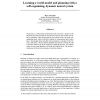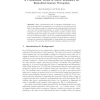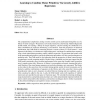22 search results - page 2 / 5 » Motor planning and sparse motor command representation |
NIPS
2003
13 years 6 months ago
2003
We present a connectionist architecture that can learn a model of the relations between perceptions and actions and use this model for behavior planning. State representations are...
IJCAI
1997
13 years 6 months ago
1997
Psychological experiments on children's development of spatial knowledge suggest experience at self-locomotion with visual tracking as important factors. Yet, the mechanism u...
IVA
2009
Springer
13 years 12 months ago
2009
Springer
Abstract. Basic communication and coordination mechanisms of human social interaction are assumed to be mediated by perception-action links. These links ground the observation and ...
JMLR
2008
13 years 5 months ago
2008
The computational complexities arising in motor control can be ameliorated through the use of a library of motor synergies. We present a new model, referred to as the Greedy Addit...
BMVC
1998
13 years 6 months ago
1998
We introduce an object recognition system in which objects are represented as a sparse and spatially organized set of local (bent) line segments. The line segments correspond to b...



